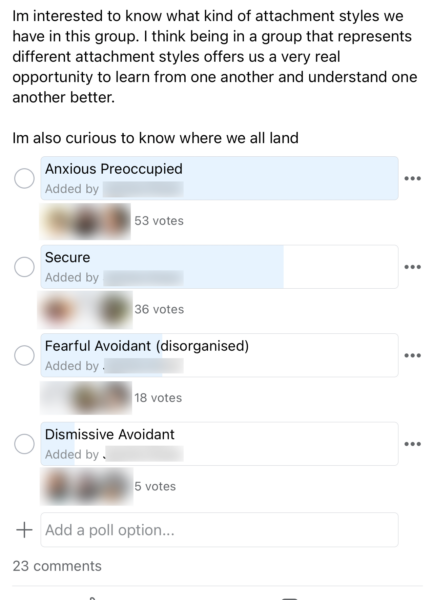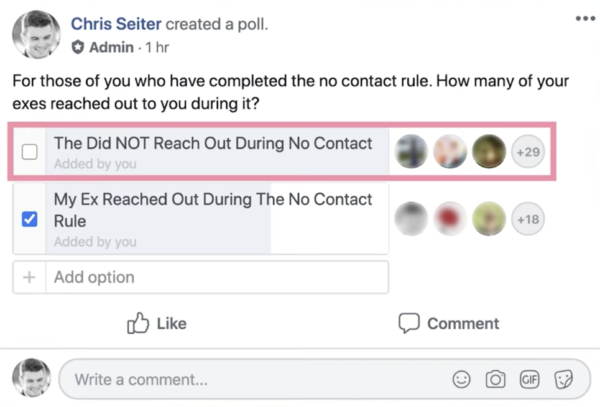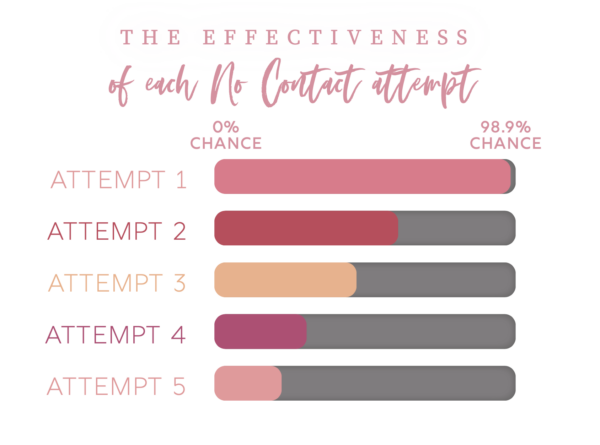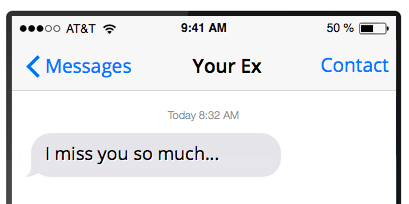I interviewed a licensed psychologist for about an hour yesterday in preparation for this discussion on how to set boundaries with an ex.
After talking with her and adding a few tweaks of my own I came up with a list of 9 boundaries that I deem essential to set after a breakup.
- Buy into the interdependence relationship concept
- Learn to identify the signs of codependency
- Do a no contact rule for you and not your ex
- Actually complete a no contact rule successfully
- Ensure you don’t obsess over your exes social media
- Listen to your body
- Learn to ask for clarity
- Learn to stand up for yourself
- Don’t be rude when setting the boundary
Alright, let’s get started!

What Are Your Chances of Getting Your Ex Boyfriend Back?
Take the quizExample #1: Buy Into The Interdependence Relationship Concept
So, I had the pleasure yesterday of interviewing a quite popular psychologist named Julia Christina.
She specializes in many different things, but among those things, she identifies codependent relationships and teaches individuals how to set boundaries.
What was really fascinating about talking to her was the intimate connection between these two concepts.
Oftentimes, people who have a codependent type relationship will struggle to set boundaries.
And so, she talked a lot in this interview about buying into the concept of an interdependent relationship.
Usually, when I ask someone, “Hey, define a codependent relationship for me,” they’re going to talk a lot about how there’s this dysfunctional relationship where one person is the caretaker, and the other person just continually takes advantage of them.
But when I asked her that question, she didn’t answer that way. She actually started talking about what a codependent relationship isn’t.
And to quote her exactly,
“To talk about what codependency is, I think we first need to talk about what codependency isn’t and what it looks like to not be in a codependent relationship.” So, the opposite of codependence isn’t independence. The opposite of codependence is interdependence. When we are in an interdependent relationship, it means that both people are there for each other, and both people have a sense of self within the relationship. Both people don’t need each other all the time. There has to be a certain element of needing a person in your life, or else what’s the point? You’re just living parallel lives as opposed to interdependent ones. So yeah, I just really think about that.
And I guess the frame of reference that you need to have when looking at an interdependent relationship is that individuals often fall into the false belief of thinking that all they need to complete their life is someone else.
You’re sitting there thinking there’s a missing piece of you, and if you could just find that one person for you, that missing piece will be filled up.
But what I think Julia astutely points out here is that that’s actually not the case.
The best relationships are typically formed when people, who don’t have any missing pieces, who feel confident and full of themselves and self-sufficient, enter into relationships with one another. And then they help each other, but they’re not totally reliant on one another.
That is essentially the first paradigm shift I think you need to undergo, especially when dealing with an ex. But we’ll get into that in a moment.
Example #2: Learn To Identify The Signs Of Codependency
I recognize it might seem unconventional to commence this article with a heavy emphasis on codependency. After all, this is something I have talked a lot about in the past.
However, from my vantage point, a significant proportion of clients who seek my coaching or avidly read articles like this often exhibit anxious attachment styles.
They frequently find themselves enmeshed in codependent relationships. Although many hesitate to acknowledge this fact, my observations affirm its accuracy. A crucial aspect of addressing this issue is discerning whether you fit this description.
So, how do you ascertain that you’re in a codependent relationship? There are several telltale indicators:

What Are Your Chances of Getting Your Ex Boyfriend Back?
Take the quiz- Anxious Attachment Style: Regrettably, our internal surveys reveal that the average individual seeking our coaching exhibits an anxious attachment style.
- Reactive Nature: If you become alarmed when your ex or partner doesn’t respond immediately, it’s a red flag. The critical nuance here is that your concern doesn’t emanate from anger due to their non-responsiveness (although this can occasionally be the case if a pattern has formed). Instead, you’re alarmed because you fear you’ve committed an error, triggering anxiety, panic, or even desperation.
- Inability to Grant Space: Should your partner desire some personal time after a taxing day—to immerse in a hobby or read a book, for instance—and your default reaction is to wonder, “What did I do? Why are they upset with me? Why this treatment?”, it signifies a codependent mindset. People with codependency often erroneously project their internal anxieties onto their partners, who might perceive situations differently.
- Resisting Their Independence: If the idea of your partner having independent friends and hobbies unsettles you, it’s another warning sign. While spending excessive time apart can be concerning, occasional outings or meet-ups with friends are normal. Those with codependency often grapple with this reality, feeling threatened and insecure, leading to unnecessary conflicts.
- Difficulty Establishing Boundaries: A defining trait of codependent individuals is their challenge in setting boundaries. Our primary goal when working with them is to instill boundary-setting skills and offer a fresh perspective. The objective isn’t to recalibrate their moral compass, but to guide them towards the merits of an interdependent relationship over a codependent one.
Example #3: Make The No Contact Rule About You
It almost goes without saying that the primary boundary you should establish with your ex is a period of no contact.
I’ve extensively discussed the no-contact rule on this website.
I thought it would be interesting to solicit the opinion of Julia, the psychologist, on this topic.
Once again, watch my interview with her here,
From my interactions with therapists and psychologists, I’ve noticed a wide spectrum of opinions about the no-contact rule.
Some of my coaching clients have shared their therapists’ perspectives on this, and there doesn’t seem to be a unanimous stance.
During my recent interview with Julia, I specifically inquired about her thoughts on the no-contact rule. She firmly believes that after a breakup, it’s essential to enforce a no-contact boundary. This gives your mind the space to recalibrate and reset. Julia emphasized that while it’s normal to want your ex back at the onset of the no-contact period, it’s best to delay this decision until the end of this phase. By then, logic rather than emotion would guide your decision-making.
I’d like to add that the no-contact rule should primarily serve your well-being. While some adopt this rule hoping it’ll make their exes miss them, our data suggests this expectation often leads to disappointment.
Our interviews with those who succeeded in reuniting with their exes revealed that they used the no-contact period to move on and evolve beyond their previous relationship dynamics.
I delve deeper into this in my articles and some of my more recent youtube videos,
Curious, I asked Julia about the ideal duration for the no-contact period.
She recommended 90 days, drawing a parallel to the typical probationary period at a new job. This span, she believes, allows enough time to adjust and comprehend new circumstances.
While I suggest a shorter timeframe of 45 days if the objective is reconciliation, I find it intriguing to hear a psychologist’s viewpoint.
Most of my recommendations about the no-contact rule align with hers, save for the duration. Ironically, many individuals who initially break the no-contact rule often end up observing a 90-day no-contact period anyway.
Example #4: Don’t Break No Contact
There’s a marked difference between setting the boundary of “I won’t communicate with my ex after this breakup” and “I won’t communicate with my ex for 45 days post-breakup.”
Forty-five days is quite a stretch, and many things can transpire during that period.
It’s common to feel the temptation or urge to break the no-contact rule.
However, breaking this rule occasionally is understandable.
The concern arises when you establish the no-contact rule, break it, reestablish it, and then break it again. This inconsistency signals to your ex that you can’t maintain boundaries.
But there’s an even bigger issue. By starting a cooling-off period and then interrupting it prematurely, you diminish the rule’s effectiveness with each successive attempt.

What Are Your Chances of Getting Your Ex Boyfriend Back?
Take the quizIt’s essential to recognize that bypassing the no-contact rule offers no real advantage.
- Exceptions might include needing to exchange items
- Being in a situation that mandates limited communication
- Ff your ex expresses a desire to reconcile and you share the sentiment.
Otherwise, there’s limited merit in breaching the rule.
To illustrate this, I consulted Julia again.
When asked about individuals who often violate the no-contact rule, she emphasized the need to reflect on one’s intentions and potential outcomes. Does breaking the rule serve a meaningful purpose? Can it guarantee the desired result?
I posed a hypothetical to her, acting as a client eager to break the no-contact rule in hopes of persuading an ex to return.
In response, she inquired if the issues that led to the breakup had been resolved.
When I mentioned the breakup resulted from a mere misunderstanding, she probed further, highlighting that such a “misunderstanding” was significant enough to cause a breakup. Could a single conversation truly resolve it and pave the way for a harmonious future?
Both Julia and I aim to emphasize that while it’s easy to delude ourselves with idealized notions of reconciliation, the reality is often different.
Many might recall the iconic scene from the 80s film where John Cusack, holding a boombox above his head, makes a grand romantic gesture.
While this might work in cinematic settings, such grand gestures seldom translate well to real-life situations during the no-contact period.
Example #5: Don’t Get Obsessed With Your Exes Social Media
This one is relatively new, but I believe it’s important.
We know from science and data that when you’re going through a breakup, your cortisol levels rise significantly.
Cortisol is often referred to as the stress hormone.
During a no-contact period, your goal is typically to lower cortisol because if it remains elevated for an extended time, you could struggle with the breakup’s effects for up to six months.
You don’t want that.
The challenge is that anything reminding you of your ex or causing jealousy or obsession about them can increase your cortisol. Social media is a double-edged sword in this context. It can be an incredibly useful tool if you’re aiming to reconcile with your ex. However, it can be detrimental if you constantly check your ex’s updates and obsess over their activities or potential new relationships.
From a psychological and neurochemical standpoint, this behavior only serves to elevate your cortisol levels, heightening stress.
It’s vital to establish this boundary for yourself, particularly if you’re inclined to obsess or if you were in a codependent relationship and are desperate for a reunion.

What Are Your Chances of Getting Your Ex Boyfriend Back?
Take the quizMy recommendation is to unfollow your ex, not unfriend them, but remain disciplined in not viewing their profiles. Many of my clients receive this advice: when it comes to social media, focus on posting rather than browsing.
Example #6: Listen To Your Body
This advice might seem obvious, but your body will often indicate when you’re ready for something and when you’re not.
A situation that comes to mind involves post-breakup dating.
Many experts, including myself, often advise that after a breakup, creating a sense of loss and appearing to move on can be beneficial.
This might mean going on dates or downloading dating apps.
Indeed, science supports that such strategies can be effective.
However, consider this: if you find yourself dreading these dates to the point of tears, as I’ve heard from some women who cried en route to post-breakup dates, it’s a clear sign from your body that you’re not ready to date again.
They may feel they’re merely going through the motions, questioning the purpose of it all. If this is how you feel, it’s alright.
Everyone adapts to post-breakup periods at their own pace, so it’s crucial to heed your body’s signals.
There’s not much more to delve into on this topic.
Simply put, if your body suggests you need a quiet weekend in, grant yourself that luxury.
Example #7: Learn To Ask For Clarity
Suppose you’re not in a no contact period and you’ve transitioned to the texting phase.
Now, imagine your ex texts you, saying they miss you.
How should you react?
The appropriate response is to seek clarity.
For instance, if your ex sends a message like “I miss you,” you could reply with a grateful acknowledgment, such as “Thank you for saying that. What do you mean by it?”
Similarly, if they comment about how good it is to hear from you, you might respond with “I appreciate that. Why are you mentioning it now?”
Setting this boundary is especially beneficial if you believe your ex has a tendency to exploit your generosity, as is often the case in codependent relationships. This behavior could manifest as leveraging you for emotional support without reciprocation.
A trend we’ve observed is that many ex-partners struggle with letting go post-breakup.
However, instead of offering commitment or other forms of intimacy, they might simply lean on you for emotional consolation.
For example, they might turn to you for advice about new relationships or personal problems, capitalizing on your willingness to help. Then, once they’ve received the support they sought, they quickly move on to their next interest.
This behavior can be likened to certain narcissistic tendencies, where narcissists thrive on a continuous supply of attention. They often possess an uncanny ability to say precisely what’s needed to lure you in, such as “I miss you” or “I love you.”
Given this, it’s crucial to always ask for clarity to understand their genuine intentions.
Example #8: Learn To Stand Up For Yourself
During the interview with Julia yesterday (I know I’ve mentioned her frequently, but I posed relevant questions for this article), I also reached out to our community.
A compelling question arose from one of our members, who asked Julia about setting boundaries with friends and family when they pressure you towards marriage or children, especially when these aren’t your immediate priorities.
Julia’s response was illuminating. She suggested saying something like,
“We haven’t made any decisions regarding this. We’ll inform you when we do. In the meantime, could you please refrain from asking?” This exemplifies the principle of standing up for oneself.
Julia highlighted an often overlooked nuance, pointing out that many who face such pressures, especially regarding marriage and family, are women. Society sometimes imposes an expectation on women to keep the peace, an expectation not always aligned with their best interests.
At times, the wisest move is to assert oneself. Yet, it’s essential to be assertive without being rude.
That leads us to our ninth boundary.
Example #9: Don’t Be Rude When Setting Your Boundaries
I’d like to introduce this concept with a quote from Julia:
“You can set boundaries in a compassionate way. Many of us, myself included, aim not to come off as rude. I never intend to hurt feelings, but I don’t want to compromise my values and comfort either. It’s about balance. How do I set a boundary that considers both my comfort and the other person’s feelings? I always think about the other’s perception, leading me to set boundaries with more empathy. That’s why I advise setting boundaries that are both clear and compassionate.”
Reflecting on Julia’s example about marriage pressure, one might interpret the initial response as slightly curt.
A gentler approach might be: “I appreciate your concern. I’m not ready to discuss this now. Can we revisit it later?”
The challenge lies in conveying your boundaries compassionately, without alienating others. Especially with ex-partners, where emotions run high, a delicate touch is paramount. Thankfully, most post-breakup communications with exes are via text, granting you the luxury of time to ponder your responses.







